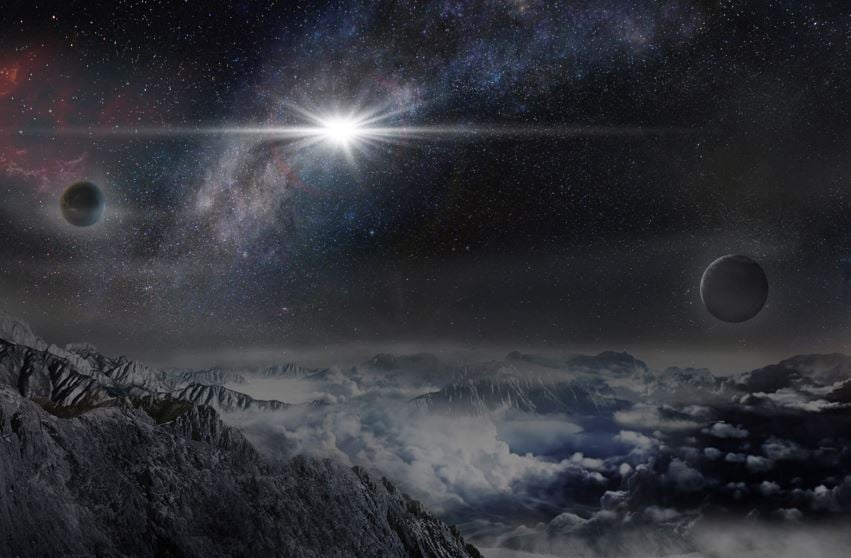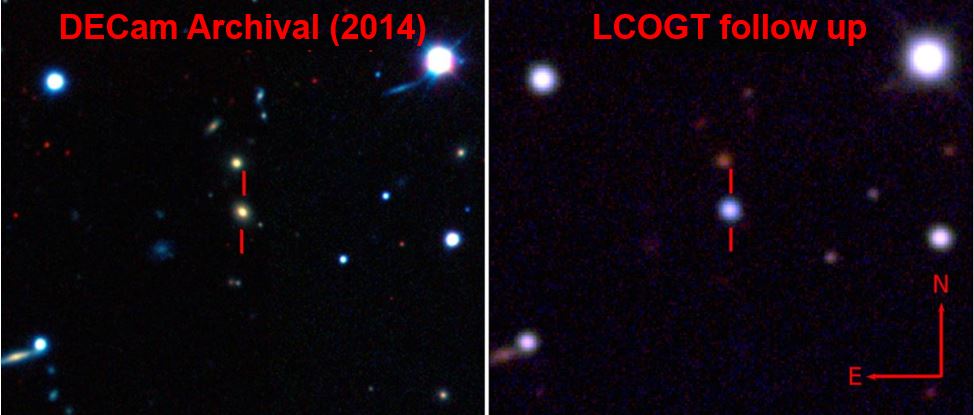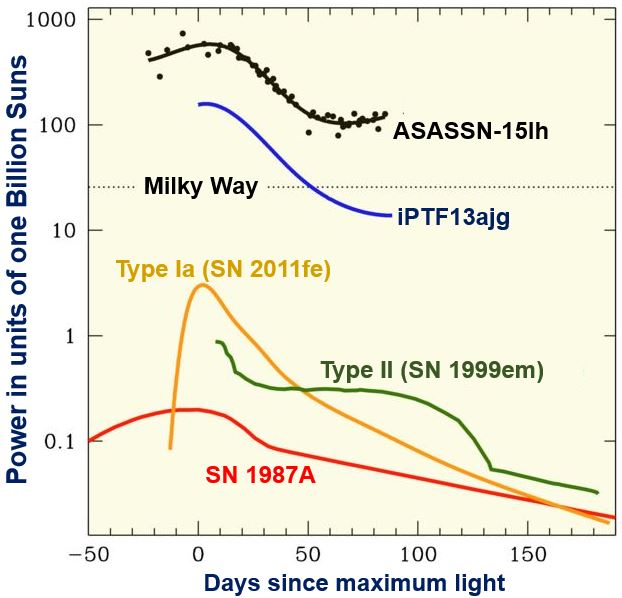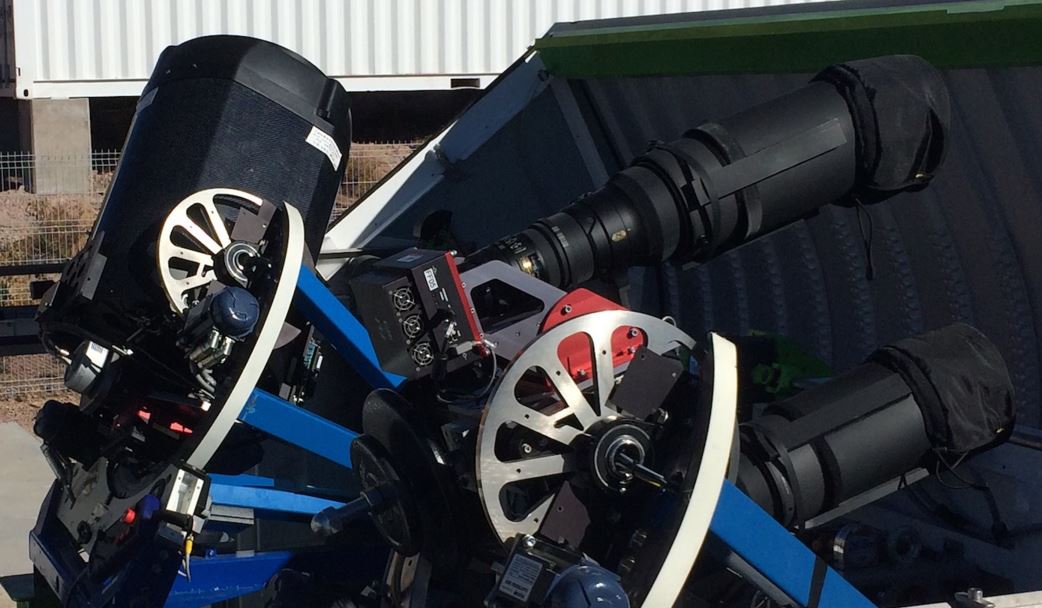A possible mega supernova – the explosion of a star – the most powerful ever seen in the Universe, has been detected. Scientists believe it is an exploding star, but are not completely sure. It could be related to some weird kind of nuclear activity around a supermassive black hole. They say they can see a ball of hot gas billions of light years from here that is radiating the energy of hundreds of billions of suns.
A supernova occurs when a star explodes – at the end of its life. It is the largest explosion in space.
The centre of this possible ultra-powerful supernova is slightly bigger than 10 miles (16 km) across, say scientists from Ohio State University.
If this is, as they suspect, a ball of gas resulting from a superluminous supernova, it is the most powerful supernova ever observed by humans on Earth. A superluminous supernova, or hypernova, is a star explosion with an energy considerably higher than that of standard supernovae
 An artist’s impression of the record-breakingly powerful, superluminous supernova ASASSN-15lh. This is what it would look like from an exoplanet just 10,000 light years away in the supernova’s host galaxy. This object, no wider than London, shines 570 billion times more brightly than our Sun. (Image: news.osu.edu. Credit: Beijing Planetarium/Jin Ma)
An artist’s impression of the record-breakingly powerful, superluminous supernova ASASSN-15lh. This is what it would look like from an exoplanet just 10,000 light years away in the supernova’s host galaxy. This object, no wider than London, shines 570 billion times more brightly than our Sun. (Image: news.osu.edu. Credit: Beijing Planetarium/Jin Ma)
Could be a magnetar
Co-principal investigator, Krzysztof Stanek, a professor in the Department of Astronomy of Ohio State University, and colleagues reported in the academic journal Science that the object at the centre might be a magnetar – a neutron star with a much stronger magnetic field than an ordinary neutron star – so strong that it pushes the energy limits allowed by the laws of physics.
The likely superluminous supernova was spotted by an international team of professional and amateur astronomers, now called ASASSN-15lh, when it first came out in a massive flare in June 2015.
Even in the disciplines of space – astronomy and astrophysics – which use mega numbers to express distance or size, the case of this small but incredibly powerful mystery object at the centre of the gas ball is so quasi-infinite that Prof. Stanek turned to the movie This is Spinal Tap to find a way to describe it.
Prof. Stanek said:
“If it really is a magnetar, it’s as if nature took everything we know about magnetars and turned it up to 11.” (i.e. 11 on a scale of 1 to 10, for those not familiar with the comedy).
 Pseudo-colour images showing the host galaxy before ASASSN-15lh exploded [Left], taken by the Dark Energy Camera (DECam). The supernova, image captured by the Las Cumbres Observatory Global Telescope Network (LCOGT) 1-meter telescope network [Right]. (Image: news.osu.edu. Credit: The Dark Energy Survey, B. Shappee and the ASAS-SN team)
Pseudo-colour images showing the host galaxy before ASASSN-15lh exploded [Left], taken by the Dark Energy Camera (DECam). The supernova, image captured by the Las Cumbres Observatory Global Telescope Network (LCOGT) 1-meter telescope network [Right]. (Image: news.osu.edu. Credit: The Dark Energy Survey, B. Shappee and the ASAS-SN team)
3.8 billion light years from here
As it is 3.8 billion light years from Earth, the gas ball that surrounds the object cannot be observed with the naked eye. It was spotted by the ASA-SN (the All Sky Automated Survey for Supernovae) collaboration. ASA-SN is pronounced ‘assassin’.
Led by Ohio State, ASA-SN uses a series of small telescopes across the globe to detect bright celestial objects in our local universe.
Since the ASA-SN collaboration was formed in 2014, it has discovered over 250 supernovae. However, the one that powered this giant one – ASASSN-15lh – makes all the others pale into insignificance.
 The light curves of ASASSN-15lh compared to other supernovae. ASASSN-15lh is about 200 times more powerful than a typical Type Ia supernova (at maximum), and it is more than twice as luminous as the previous record-holding supernova, named iPTF13ajg. (Image: news.osu.edu. Credit: the ASAS-SN team)
The light curves of ASASSN-15lh compared to other supernovae. ASASSN-15lh is about 200 times more powerful than a typical Type Ia supernova (at maximum), and it is more than twice as luminous as the previous record-holding supernova, named iPTF13ajg. (Image: news.osu.edu. Credit: the ASAS-SN team)
Unimaginably powerful celestial object
This giant is two hundred times more powerful than the average supernova. It is 570 billion times brighter than our Sun.
If you combined the brightness of all the stars in our Milky Way, they would only reach one-twentieth of the brightness of ASASSN-15lh – and our galaxy is huge, over 100,000 light years in diameter.
Prof. Stanek said:
“We have to ask, how is that even possible? It takes a lot of energy to shine that bright, and that energy has to come from somewhere.”
Lead author, Subo Dong, a Youth Qianren Research Professor of astronomy at the Kavli Institute for Astronomy and Astrophysics at Peking University, said:
“The honest answer is at this point that we do not know what could be the power source for ASASSN-15lh.”
 Two of the 14-centimeter diameter lens telescopes used for ASAS-SN that discovered ASASSN-15lh. Since this image was taken, two more telescopes have been added to the ASAS-SN station in Cerro Tololo, Chile. (Image: news.osu.edu. Credit: Wayne Rosing)
Two of the 14-centimeter diameter lens telescopes used for ASAS-SN that discovered ASASSN-15lh. Since this image was taken, two more telescopes have been added to the ASAS-SN station in Cerro Tololo, Chile. (Image: news.osu.edu. Credit: Wayne Rosing)
Prof. Dong added that this discovery will probably lead to new thinking and new observations of the whole class of superluminous supernova.
Object may be spinning 1000 times per second
Todd Thompson, Professor in the Department of Astronomy at Ohio State, offered one possible explanation. The supernova could have given birth to a millisecond magnetar, an extremely rare type of dense star that spins rapidly and has an extremely strong magnetic field.
To shine so brightly, this magnetar, if it is one, would also have to spin at least one thousand times per second, and convert all that rotational energy into light with almost 100% efficiency, Prof. Thompson explained.
This discovery would be the most extreme example of a magnetar, according to our current knowledge of what is scientifically possible.
Prof. Thompson said:
“Given those constraints, will we ever see anything more luminous than this? If it truly is a magnetar, then the answer is basically no.”
Later this year, the Hubble Space Telescope will help settle the question, partly because it will allow astronomers to observe the host galaxy where the object resides.
Could be supermassive black hole related
If the object is found to be in the very centre of a large galaxy, then it might not be a magnetar at all, and the gas surrounding it not evidence of a supernova, but rather some unusual nuclear activity around a supermassive black hole.
If it is supermassive black hole related, then its bright light could herald an entirely new kind of event, said co-author Christopher Kochanek, Ohio Eminent Scholar in Observational Cosmology.
Citation: “ASASSN-15lh: A highly super-luminous supernova,” Subo Dong, B. J. Shappee, J. L. Prieto, S. W. Jha, K. Z. Stanek, T. W.-S. Holoien, C. S. Kochanek, T. A. Thompson, N. Morrell, I. B. Thompson, U. Basu, J. F. Beacom, D. Bersier, J. Brimacombe, J. S. Brown, F. Bufano, Ping Chen, E. Conseil, A. B. Danilet, E. Falco, D. Grupe, S. Kiyota, G. Masi, B. Nicholls, F. Olivares E., G. Pignata, G. Pojmanski, G. V. Simonian, D. M. Szczygiel21, P. R. Woźniak. Science. 15 January, 2015. Vol. 351, Issue 6270, pp. 257-260. DOI: 10.1126/science.aac9613.
Video – Brightest supernova ever
